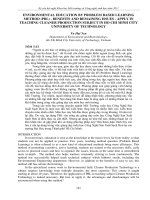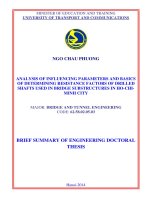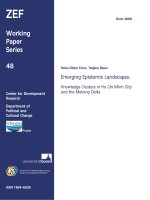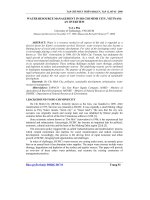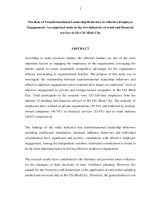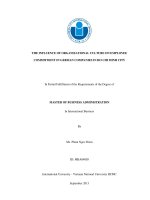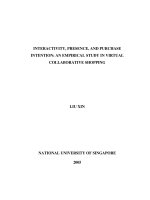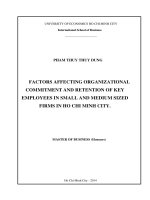Organizational citizenship behavior and employee turnover intention an empirical study in pharmaceutical companies in ho chi minh city
Bạn đang xem bản rút gọn của tài liệu. Xem và tải ngay bản đầy đủ của tài liệu tại đây (903.3 KB, 101 trang )
UNIVERSITY OF ECONOMICS HO CHI MINH CITY
International School of Business
------------------------------
Than Thi Thanh Thuyen
ORGANIZATIONAL CITIZENSHIP
BEHAVIOR AND EMPLOYEE
TURNOVER INTENTION: AN
EMPIRICAL STUDY IN
PHARMACEUTICAL COMPANIES IN
HO CHI MINH CITY
MASTER OF BUSINESS (Honours)
Ho Chi Minh City – 2017
1
UNIVERSITY OF ECONOMICS HO CHI MINH CITY
International School of Business
------------------------------
Than Thi Thanh Thuyen
ORGANIZATIONAL CITIZENSHIP
BEHAVIOR AND EMPLOYEE
TURNOVER INTENTION: AN
EMPIRICAL STUDY IN
PHARMACEUTICAL COMPANIES IN
HO CHI MINH CITY
ID: 22140053
MASTER OF BUSINESS (Honours)
SUPERVISOR: Dr. TRAN HA MINH QUAN
Dr. NGUYEN THI NGUYET QUE
Ho Chi Minh City – 2017
2
Acknowledgment
I would like to express my deep gratitude to my supervisor Dr. Tran Ha Minh
Quan and Dr. Nguyen Thi Nguỵet Que for their precious guidance, valuable suggestions
and advice as well as their immense knowledge to support me throughout the process.
In addition, I would like to thank my family, my friends and my colleagues for
their constant encouragement and immediate helps without which the study would not
have been possible.
3
Abstract
The study investigates the influence of relations-oriented leadership behavior, perception
of fairness and intrinsic motivation on organization citizenship behavior (OCB) and the
influence of OCB on employee turnover intention in the context of Vietnam
pharmaceutical industry. The model was tested with a sample of 312 employees working
for pharmaceutical companies in Ho Chi Minh City. The result reveals a good fit between
collected data and measurement scales which were introduced and developed in the
Western contexts. The findings show that relations-oriented leadership behavior,
perception of fairness and intrinsic motivation has positive impacts on OCB, and OCB
has a negative impact on employee turnover intention. The discovery highlights the
importance of documenting factors affecting OCB in reducing employee turnover
intention towards organization as well as draws the management attention to their
recruiting, training and long term development policies.
Key words: Organizational Citizenship Behavior, turnover intention, relations-oriented
leadership behavior, perception of fairness, intrinsic motivation
4
Table of contents
Acknowledgement
Abstract
Table of Contents
1.
2.
3.
4.
5.
Introduction ................................................................................................................................... 9
1.1.
Research background ............................................................................................................ 9
1.2.
Research problem ................................................................................................................ 10
1.3.
Research questions and research objectives ........................................................................ 12
Theoretical Background and Hypotheses ................................................................................... 13
2.1.
Organizational citizenship behavior .................................................................................... 13
2.2.
Employee turnover intention ............................................................................................... 14
2.3.
Relations-oriented leadership behavior ............................................................................... 14
2.4.
Perception of fairness ........................................................................................................... 16
2.5.
Intrinsic motivation.............................................................................................................. 17
2.6.
OCB and employee turnover intention................................................................................ 19
Research methodology ................................................................................................................. 22
3.1.
Procedure and Sample ......................................................................................................... 22
3.2.
Measurement scales ............................................................................................................. 23
3.3.
Data analysis ........................................................................................................................ 25
Results .......................................................................................................................................... 26
4.1.
Descriptive analysis .............................................................................................................. 26
4.2.
Reliability test....................................................................................................................... 27
4.5.
Structural Equation Modeling (SEM) ................................................................................. 38
4.6.
Discussion ............................................................................................................................. 42
Conclusion, implications and limitation ...................................................................................... 43
5.1.
Conclusion ............................................................................................................................ 43
5.2.
Managerial Implications ...................................................................................................... 44
5.3.
Limitations and directions for future research ................................................................... 46
5
References............................................................................................................................................. 47
APPENDIX........................................................................................................................................... 67
Appendix 1- Questionnaire – English................................................................................................. 67
Appendix 2 - Questionnaire – Vietnamese ......................................................................................... 73
Appendix 3- Description of study sample........................................................................................... 78
Appendix 4- Reliability analysis - relations-oriented leadership behavior ........................................... 81
Appendix 5- Reliability analysis - Perception of fairness .................................................................... 82
Appendix 6- Reliability analysis – Intrinsic motivation ...................................................................... 83
Appendix 7- Reliability analysis – Organizational Citizenship Behavior ............................................ 84
Appendix 8- Reliability analysis – Turnover intention........................................................................ 85
Appendix 9- Exploratory Factor Analysis (EFA)................................................................................ 86
Appendix 10 – Confirmatory Factor Analysis (CFA) ......................................................................... 91
Appendix 11- Structural Equation Modeling (SEM)........................................................................... 97
6
List of figures
Figure 1. Conceptual Model .............................................................................................. 21
Figure 2. CFA measurement model................................................................................. 376
Figure 3. SEM measurement model ................................................................................ 378
7
List of tables
Table 1. Source of data collection .................................................................................... 26
Table 2. Overall reliability of the constructs and standardized loadings of indicators. ... 29
Table 3. EFA results for measurement scales ................................................................... 35
Table 4. Factor colleration ................................................................................................. 35
Table 5. Fit indices for the test model result (CFA) .......................................................... 37
Table 6. Fit indices for the test model result (SEM) ......................................................... 39
Table 7. Standardized structural paths in the model ......................................................... 40
8
1. Introduction
1.1.
Research background
Employee is considered as one of the most valuable assets and this becomes competitive
advantage of every organization in modern economy (Verma & Dewe, 2008). According
to Dobre (2012), human capital has a direct relationship to organizational performance in
terms of company’s profit and targets. Other studies found that maintaining a stable labor
force is an optimal way to obtain effective cost management and enhance quality of
service in a firm (Jago & Deery, 2002) as well as achieve sustainable economic
development of a nation (Bousrih, 2013). However, keeping well trained and skilled
employees is getting more difficult for any organization (Wiggins, 1998) and it is
becoming an important challenge for the firms (Reda & Dyer, 2010) as employee will
switch to the next job if they are not satisfied with the current employer or the job and
employer will be left with no good employees in organization (Laddha, Singh, Gabbad &
Gidwani, 2012). Furthermore, employer has to suffer many losses such as investment in
recruitment, selection, training and promotion is wasted (Abrams, Ando & Hinkle, 1997),
negative influences on work flow, quantity and quality of production as well (Guthrie,
2000) if valued workers leave. So, keeping suitable and well-trained employees are
becoming the priority in every organization (Mitchell, Holtom & Lee, 2001).
There are many reasons why people leave organizations: family matter, unfair
treatment observation (Mitchell et al., 2001), salary level, job satisfaction (Lee, Huang &
Zhao, 2012), excess workloads, poor colleague relationships (Conklin & Desselle, 2007),
9
perceived organizational support, or employment external opportunities perception
(Hofaidhllaoui & Chhinzer, 2014). Another factor that can be taken into consideration is
discretionary work behavior, or Organizational Citizenship Behavior (OCB). OCB is
defined as employee’s willingness to contribute extra efforts for the achievement of
organizational outcomes, willingness to help coworkers, or willingness to obey extra
rules (Katz, as cited in Jahangir, Akbar & Haq, 2014) and it is not in formal reward
system of organization (Teh, Boerhannoeddin & Ismail, 2012; Konovsky & Pugh, 1994).
If employee has high OCB, their turnover intention is likely to reduce so OCB can be
considered as one of the important impacts on employee turnover intention.
1.2.
Research problem
Organizational Citizenship Behavior (OCB) has been studied widely over many years by
many researchers. Its outcomes are also stated including increased employees’
satisfaction (Aamir & Zafar, 2006), enhanced employees retention (Podsakoff &
Mackenzi, as cited in Chahal & Mehta, 2011) which means reduced turnover (Aamir &
Zafar, 2006). Studies have shown that organizations with high OCB levels can have
positive outcomes such as lower levels of turnover and higher levels of efficiency
(Podsakoff, Whiting, Podsakoff & Blume, 2009). The benefits of OCB can be great, and
the antecedents of OCB haven been studied widely so that managers can provide an
appropriate environment to foster OCB’s in their employees (Lilly, 2015). Impacts of
OCB on employee turnover intention have been widely studied in terms of job
10
satisfaction (Bolon, 1997; Alotaibi, 2001; Lee et al., 2012; Hofaidhllaoui & Chhinzer,
2014), organizational commitment (Bolon, 1997; Alotaibi, 2001; Lee et al., 2012;
Conklin & Desselle, 2007), organizational support (Kamani & Namdari, 2012; Pohl,
Battistelli & Librecht, 2013) or leadership style (Jiao, Richards & Zhang, 2011; Suliman
& Obaidli, 2013; Lilly, 2015; Shah, Hamid, Memon & Mirani, 2016) but the main field
of investigation is in hotel (Lee et al., 2012), engineer (Hofaidhllaoui & Chhinzer, 2014)
telecom (Ibrahim & Aslinda, 2014), hospital (Pohl et al., 2013) or finance - banking
industry (Jiao et al., 2011; Kamani & Namdari, 2012; Suliman & Obaidli, 2013; Shah et
al., 2016) in the U.S, Pakistan, Indonesia... Whereas in Vietnam, turnover rate in
pharmaceutical companies is still increasing year by year and it continues to be in top
three out of 15 industries, even though salary is increased (Towers Watson Vietnam
,2014; Talentnet – Mercer Total Remuneration Survey, 2015). According to Towers
Watson Vietnam (2014), its Total Rewards Survey 2014 highlighted that the general
industry average staff turnover rate in Vietnam is at 12.7%, higher than the median of
11%. By sector, the survey showed that the pharmaceutical industry is the highest not
only in terms of overall salary increases with 11.2%, but also in terms of staff turnover
rate at 15.9%. Furthermore, Talentnet – Mercer Total Remuneration Survey (2015) made
a survey with participant list of 520 well-established Multinational Corporations and
leading local companies from 15 industries. In this year, Pharmaceutical is still in top
three industries providing the highest salary increase rate in the market with 10.1% but
staff turnover rate is also in top three accounting for 16.7%. It can be seen that employee
turnover rate in increasing and becoming big concern for organization, especially in
11
pharmaceutical industry where increased salary still cannot reduce high turnover rate.
Employee turnover will inflict numerous costs such as losing valuable knowledge and
experience; affecting the normal workflow of the companies, the efficiency of business
and relationships with suppliers and customers (Mitchell et al., 2001). Consequently, how
to explore the OCB factors that can reduce employee turnover intention becomes the big
problem for management to face and deal with in order to run the business well.
The result of the research is important to bring the awareness to the managers in
Pharmaceutical industry in Ho Chi Minh City about antecedents of OCB that affect
employee turnover intention. Management can make appropriate policies for employees
to reduce their turnover intention and increase their working efficiency.
- The research can be useful the reference or guidance for the others to conduct further
studies in related topics and other organizations regards to similar problems.
- The research can be believed to add more value to the literature on OCB and employee
turnover intention, especially in Vietnam setting.
1.3.
Research questions and research objectives
According to the above mentioned research background and research problem, this
research aims to investigate the following questions:
RQ1: Identify the antecedents of Organizational Citizenship Behavior and how does each
antecedent affect Organizational Citizenship Behavior?
12
RQ2: How does Organizational Citizenship Behavior affect employees’ turnover
intention?
The main objectives of this research are to:
- Identify factors affecting Organizational Citizenship Behavior including relationsoriented leadership behavior, perception of fairness, intrinsic motivation and the extent to
which each factor affects Organizational Citizenship Behavior.
- Analyze the impacts of Organizational Citizenship Behavior on employees’ turnover
intention
2. Theoretical Background and Hypotheses
2.1.
Organizational citizenship behavior
Organizational citizenship behavior (OCB) can be interpreted within the framework of
social exchange theory: employees are willing to perform extra role behaviors to satisfy
and reward relationships with specific individuals or groups in the workplace
(Cropanzano & Mitchell, 2005). According to Konovsky and Pugh (1994), OCB is
“employee behavior that is above and beyond the call of duty and therefore is
discretionary” (p. 656) and OCB is not rewarded in organizational formal structure. Lilly
(2015) defined OCB as positive employee behavior that is not required for the job in
order to help the organization or to protect the organization from arising problems.
Successful organizations will be organizations that have employees willing to go
beyond their normal job responsibilities, give their time and energy to complete the
13
assigned job successfully, and contribute to organizational smooth operations. As the
result, organizations cannot operate well without having good OCB behaved employees
and understanding OCB has been a high priority for organizational management
(Jahangir et al., 2014).
2.2.
Employee turnover intention
Turnover intention has been widely studied in academic community. According to Cotton
and Tuttle (1986), turnover intention is an individual’s perceived probability of staying or
leaving a current organization while Sousa-Poza and Henneberger (2004) stated that
“Turnover intention reflects the (subjective) probability that an individual will change his
or her job within a certain time period” (p. 113) and Tett and Meyer (1993) defined this
term as employee’s willingness to seek for other opportunities in other organizations.
Turnover intention has always been an important issue for management for many
years and it is a major problem for organizations until now (Chen, Lin & Lien, 2011).
Researchers also stated that organizations are giving increased attention to turnover
intention problem because they know that it will affect the cost and the performance of
organizations.
2.3.
Relations-oriented leadership behavior
According to Lilly (2015), leadership behavior is classified into two basic types: task
focused behavior and people behavior focused on people, also called relations-oriented
leadership behavior. In general, fast work speed, good quality, high quantity, and close
14
supervision are focused on task focused behavior. On the other hand, nurturing
relationships, less close supervision, stress reduction, trust and respect people in the
workplace are factors that will be concentrated in relations-oriented leadership behavior.
Tucker and Russell (2004) argued that transformational leadership (similar to
relations-oriented leadership) adds to the quality of life in the employee and the
organization. Jiao et al. (2011) pointed out that under influence of relations-oriented
leaders; employees will recognize and accept the values of the organization and the
leader. As the result, they do not only perform their job for obligation or reward, they
actually transform their attitudes, beliefs, and values (Bono & Judge, 2003; Rafferty &
Griffin, 2004). Krishnan (2012) stated that transformational leadership is positively
related to employees’ meaning of life and subjective well-being. Due to impact of
relations-oriented leadership on personal and organizational outcomes, it is needed in all
organizations (Tucker & Russell, 2004).
Leadership always plays an important role in every business organization, it is
sought to identify the behaviors that can improve the performance of individual and
organization (Yukl, Gordon & Taber, 2002). Employees can be motivated or demotivated
according to their working and cooperation with their leaders. Yan and Yan (2013)
pointed out that relations-oriented leaders tend to increase cooperation, teamwork and job
satisfaction. Examples can be seen as looking out for welfare of employees, being willing
to accept employees’ suggestions (Yan & Yan, 2013), helping employees to perform the
task better or giving praise when they perform the tasks effectively (Yukl et al., 2002).
15
Relations oriented leadership behavior includes supporting, developing,
recognizing, consulting and empowering with individuals (Yukl et al., 2002) and it can be
seen to enhance team spirit and influence on the employee’s engagement in OCB (Chahal
& Mehta, 2011; Jahangir et al., 2014). Furthermore, many researchers have found that
supportiveness can help employees cope with stress and reduce interpersonal conflicts
(Amason 1996; Jehn 1995; Whetten & Cameron 1991, as cited in Yan & Yan, 2013).
Netemeyer, wBoles, McKee & McMurrian (1997) also said that leadership support
behaviors can increase job satisfaction which effects positively on employee’s OCB.
Podsakoff et al (as cited Yan & Yan, 2013) showed that supportive leadership perception
is positively associated with OCB. All these suggest that employee’s OCB can be
enhanced by relations-oriented leadership behavior. Thus, the following hypothesis is
developed:
H1: Relations-oriented leadership behavior has a positive effect on employee’s OCB
2.4.
Perception of fairness
Fairness or justice perception is defined as whether or not employees feel organizational
decisions are made fairly and in the same way with the necessary employee input (usually
called procedural justice) and whether or not employees feel that they are fairly treated
rewarded (called distributive justice) (Jahangir et al., 2014).
Organ (as cited in Messer & White, 2006) argued that fairness perception is
important as employees who believe that they are fairly treated will hold positive
attitudes about their work and outcomes.
16
Williams, Pitre and Zainuba (2002) stated that employees are always concerned
fairness treatment in the organization. Buluc (2015) stated that one of the most significant
influences on employees is employees’ perception of fairness in organization.
Employees’ fairness perception is defined as perception that they have been fairly treated
or not (Moorman, as cited in Messer & White, 2006). Concerning fairness perception
effects; Ertürk, Yilmaz, and Ceylan (2004) posited that employee perceptions of
managerial fairness will be a more important factor of OCB than other factors such as job
satisfaction or organizational commitment.
Organ (as cited in Messer & White, 2006) believed that employees will have
positive working attitudes if they are fairly treated; he also argued that employees’
perception of fairness plays an important role in creating OCB. Employees will increase
their OCB if they receive and perceive that they are fairly treated. Furthermore, Williams
et al. (2002) also proved that employee’s OCB intentions increase when their fairness
perception becomes positive. Chahal and Mehta (2011) pointed out that fairness
perception may increase cohesive employees within organization and turn to increase
OCB. Based on these studies, the following hypothesis is developed:
H2: Perceptions of fairness has a positive effect on employee’s OCB
2.5.
Intrinsic motivation
Intrinsic motivation is defined in Cognitive evaluation/self-determination theory
(CET/SDT) as the willingness to pursue an activity based on one’s interest and personal
17
capacity to do so (Ryan & Deci, 2000). The researchers also pointed out that intrinsic
motivation refers to willing to do something because it is interesting or enjoyable
Teleonomic theory of self (TTS) describes intrinsic motivation as “deep
absorption and full involvement in an activity” (Keller &Bless, as cited in
Yogarabindranath, 2013).
Intrinsic motivation is defined as the willingness to perform an activity for the
interest or enjoyment of the activity itself, it does not mean to another reward (Isen &
Reeve, 2005). Researchers have shown that intrinsic motivation has a positive effect on
employees’ creativity (Ryan & Deci, 2000), job satisfaction and well-being (Ilardi,
Leone, Kasser, & Ryan, 1993), affective commitment (Eby, Freeman, Rush, & Lance,
1999) and job performance (Guo, Liao, Liao & Zhang, 2014).
Chahal and Mehta (2011) found that in order to enhance OCB, motives play an
important part. The finding of Rodriguez (as cited in Ibrahim & Aslinda, 2014) showed
that intrinsic motivation relating with employees’ OCB is stronger than extrinsic
motivation. He also confirmed that variable of intrinsic motivation has a great effect on
employee’s OCB. According to Ying-Wen (2012), intrinsic work values enhance intrinsic
career success such as satisfaction with employee’s job and with his/her career. Erdogan,
Kraimer and Liden (2014) pointed out that employees may remain committed and work
productively when they have intrinsic values. They also tend to protect company property
and comply with informal rules that are created for work efficiency. When employees see
their intrinsic values and career, they will have intrinsic motivation; they will
18
automatically engage in the job as they find interesting and enjoyable when performing
their job, they are also willing to help each other to complete their jobs efficiently. When
intrinsic motivation is high, employees consider citizenship behaviors as free choice and
beneficial, they enjoy working and helping others (Gagné & Deci, 2005) Therefore,
intrinsic motivation may have a significant positive impact on OCBs. Furthermore,
Lazauskaite-Zabielske, Urbanaviciute & Bagdziuniene (2015) stated that the more
intrinsic motivation the employees have, the more they enjoy their work and care about
benefits and good results, the more willing they will help and respect their colleagues as
well as follow company regulations and participate in company activities. As the result,
the employees will be more engaged in OCB and be active members of the company.
The following hypothesis is proposed according to the above mentioned studies:
H3: Intrinsic motivation has a positive effect on employee’s OCB
2.6.
OCB and employee turnover intention
According to Priyadharshini and Mahadevan (2014), OCB is defined as the extent in
which employees feel they belong to the organization and OCB can enhance the ability to
retain employees in organization (Podsakoff & Mackenzie, 1997, as cited in
Priyadharshini & Mahadevan, 2014). Chen, Hui and Sego (1998) proved that lower OCB
levels relate to unwillingness to involve and to stay in the organization. If employees
experience a positive working environment in the organization, they tend to be more
committed and motivated (Cohen, 2006), and these motivated and committed employees
are negatively related to turnover. In addition, employees who are satisfied, committed,
19
and with organizational citizenship behavior are likely to stay in their current
organizations. Paillé, Raineri and Valeau (2015) also proved that the more OCB
employees demonstrate, the less they want to leave their organization. Other researchers
also argued that OCB is negatively related to employee turnover (Nathan, Steven, Philip
& Brian, 2009; Paillé, 2013; Yafang & Shih, 2010). Thus, the following hypothesis is
proposed:
H4: OCB has a negative effect on employee turnover intention
20
Relations-oriented
leadership
behavior
H1 (+)
Perceptions of
fairness
H2 (+)
Organizational
Citizenship
Behavior
H4 (-)
Employee turnover
intention
H3 (+)
Intrinsic
motivation
Figure 1. Conceptual Model
21
3. Research methodology
3.1.
Procedure and Sample
The research was conducted in Ho Chi Minh City. Two phases of study, a pilot study and
a main survey, were undertaken to collect data for testing the proposed model. The
respondents were employees at many levels in various types of pharmaceutical
companies in Ho Chi Minh City.
Although most of the measures of constructs in the model are available in the
literature, it is important to ensure they are appropriate for the Vietnamese context,
especially for pharmaceutical companies in Ho Chi Minh City. In-depth interviews with 7
employees in pharmaceutical companies were conducted to modify the measures by
examining how they describe relations-oriented leadership behavior, perception of
fairness, intrinsic motivation, OCB, and turnover intention. This study is very important
to make them appropriate for the pharmaceutical field context of this study.
The structured questionnaire was created by Google Form. The questionnaire was
sent to a convenience sample of 2,496 respondents. The author was working in HR
Department of a pharmaceutical company (Altus Pharmaceutical Co., Ltd) while doing
this research. There was an HR database of all candidates who applied for all positions of
Altus Co.,. Full names, phone numbers and emails of all candidates are stored in this
database. There were 2,496 candidates in the database including people who were
currently working in pharmaceutical companies, just left from pharmaceutical companies,
just applied to pharmaceutical companies or were working in non-pharmaceutical
22
companies. All of them could be appropriate respondents and the reliability of the
research can be high if large amount of them in 2,496 people sent their feedbacks. That’s
why the author copied the link in the email and stated clearly in the email that the
respondents should help by sending feedback if they were currently working in
pharmaceutical companies. In these 2,496 respondents, 312 of them were satisfied this
condition and sent their feedbacks. The feedbacks then were used to assess the scale and
test the proposed hypotheses by means of Cronbach’s alpha and exploratory factor
analysis (EFA).
The purpose of this main study is to validate the measures and to test the
structured model. The data collected from the pilot study was used to refine the measures
by means of Cronbach’s alpha reliability and exploratory factor analysis (EFA). After
that, confirmatory factor analysis (CFA) was used to test the measures validation and to
test the structural model by means of structural equation modeling (SEM).
3.2.
Measurement scales
Five constructs were examined: Relation-oriented leadership behavior, perception of
fairness, intrinsic motivation, organizational citizenship behavior, and employee turnover
intention. Relation-oriented leadership behavior was measured by six items borrowed
from Avolio, Bass and Jung (1999), Suliman and Obaidli (2013), Hemsworth, Muterera,
and Baregheh (2013) and based on results of pilot study. Perception of fairness was
measured by four items adapted from Moorman (1991), Niehoff1 and Moorman (1993),
Jafari and Bidarian (2012). Intrinsic motivation was measured by five items borrowed
23
and adapted from Rioux and Penner (2001), Finkelstein (2011). Turnover intention was
measured by three items, adapted from Lichtenstein, Alexander, McCarthy and Wells
(2004), Paillé and Grima (2011), Paillé et al. (2015). Although Organ’s five-dimension
framework has been widely used in many previous research ((Moorman, 1991;
Podsakoff, Mackenzie, Moorman & Fetter, 1990), current researchers have not agreed
upon specific dimensions for OCB. LePine, Erez and Johnson (2002) conducted a metaanalysis to examine the relationship among these dimensions and suggested that
researchers should consider OCB at the aggregate level and distinguish OCB by the
target towards whom such behavior is directed. Thus, this study used a two-factor model:
OCB directed at individuals (OCBI) and directed at organization (OCBO).
Organizational Citizenship Behavior Questionnaire (Lee & Allen, 2002) developed the
scale with 16 statements including eight items for OCBO and eight items for OCBI.
McNeely and Meglino (1994), Williams and Anderson (1991) stated that using these two
subscales to distinguish may be problematic because they will be overlapped. In these
studies, the items that are beneficial to individuals and to the organization were selected
to avoid possible overlap. Eight items reflecting OCBI and OCBO were selected (see the
Appendix).
Five-point Likert-type scale ranged from 1 (strongly disagree) and 5 (strongly
agree) was used for all items in this study. A questionnaire of the survey included 21
main questions, the remaining part contained questions related to gender, age, position,
education…to collect biodata The questionnaire was initially prepared in English and
24
then translated into Vietnamese. This procedure was organized because English is not
well understood by all employees in Vietnam.
3.3.
Data analysis
Cronbach’s alpha reliability and Exploratory Factor Analysis (EFA) were used to refine
the measures of constructs based on the data collected in the quantitative pilot study (n =
312).
Cronbach’s alpha calculation was used to examine the inter-item consistency
reliability of global variables and their components. After that, EFA with the "Principal
Axis Factoring" extraction method with the "Promax" rotation is used in factor analysis.
Next, model proposed in Figure 1 will be evaluated with Structural Equation Modeling
(SEM) to test the general fit of the proposed model and to test the hypotheses. After that,
all within-construct discriminant validity and convergent validity were examined if they
are satisfied for Confirmatory Factor Analysis (CFA) and Structure Equation Modeling
(SEM). Finally, CFA and SEM were examined if the measurement model received an
acceptable fit.
25
